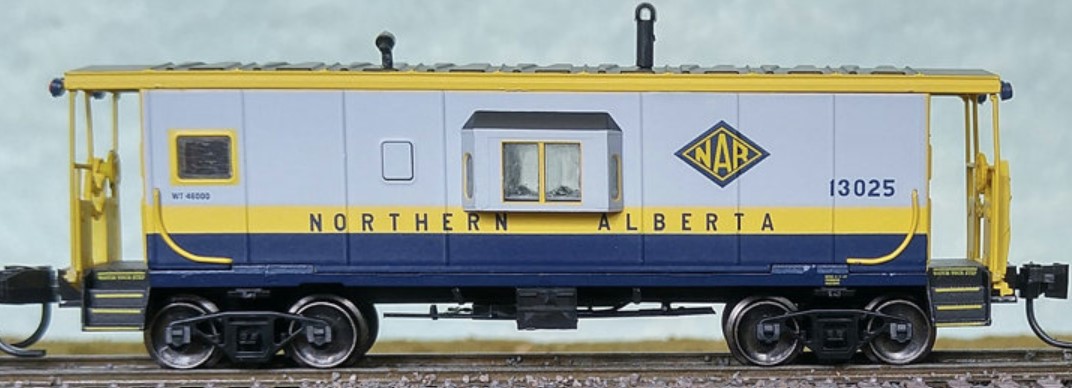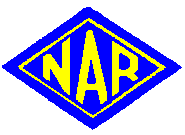Prototype History: In a bay window caboose, the crew monitoring the train sits in the middle of the car in a section of wall that projects from the side of the caboose. The windows set into these extended walls resemble architectural bay windows, so the caboose type is called a bay window caboose. This type afforded a better view of the side of the train and eliminated the falling hazard of the cupola. The bay window gained favor with many railroads because it eliminated the need for additional clearances in tunnels and overpasses. On the west coast, the Milwaukee Road and the Northern Pacifc Railway used these cars, converting over 900 roof top cabooses to bay window cabooses in the late 1930's. Milwaukee Road rib-side window cabooses are preserved at New Libson, Wisconsin, the Illinois Railway Museum, the Mt. Rainer Scenic Railroad, and Cedarburg, Wisconsin.
When the shift was made from wooden to steel caboose construction, a new type of caboose also arrived. The new caboose design replaced the traditional roof-mounted “cupola” with “bay-windows” attached to the sides of the caboose. As freight cars grew taller, the effectiveness of cupolas as practical observation points was diminished. This was especially true on lines that suffered from low clearances and were incapable of making cupolas high enough to see over the top of the tallest freight cars. Cabooses were prone to rough handling, and many a trainman was knocked out of his perch in the cupola and injured when he fell. The new caboose design was safer as well as more effective.
When the shift was made from wooden to steel caboose construction, a new type of caboose also arrived. The new caboose design replaced the traditional roof-mounted “cupola” with “bay-windows” attached to the sides of the caboose. As freight cars grew taller, the effectiveness of cupolas as practical observation points was diminished. This was especially true on lines that suffered from low clearances and were incapable of making cupolas high enough to see over the top of the tallest freight cars. Cabooses were prone to rough handling, and many a trainman was knocked out of his perch in the cupola and injured when he fell. The new caboose design was safer as well as more effective.
Road Name History: NAR came together in 1929 when several railroads were combined under joint ownership of Canadian National and Canadian Pacific. One line ran from Edmonton, Alberta northeast to Lac La Biche and then Fort McMurray. The other line ran northwest from Edmonton to Smith where it turned west for Grande Prairie and ultimately to Dawson Creek just over the British Columbia border. A branch came off that main at McLennan north to Peace River then west to Hines Creek. Traffic on these lines was mostly grain.
In 1958, Pacific Great Eastern finished their line to Dawson Creek from the Pacific coast. This and new highways in the area syphoned traffic from NAR. In 1964, CN opened their isolated (from other CN lines) Great Slave Lake Railway from a junction on the NAR near Peace River to mines in the sub-Arctic region. This added considerable lead and zinc ore traffic to the NAR. Nevertheless, trains were infrequent on the NAR. With 923 route miles, NAR required just 21 diesels. The diesel fleet consisted of 10 GP9’s, 7 GMD1’s, and 4 SD38-2’s. To put that into perspective, the busy Clinchfield Railroad required nearly five times as many locomotives to run less than a third of the mileage.
In 1980, Canadian Pacific sold their half of NAR to Canadian National and on the first day of 1981, NAR operations were folded into CN.
In 1958, Pacific Great Eastern finished their line to Dawson Creek from the Pacific coast. This and new highways in the area syphoned traffic from NAR. In 1964, CN opened their isolated (from other CN lines) Great Slave Lake Railway from a junction on the NAR near Peace River to mines in the sub-Arctic region. This added considerable lead and zinc ore traffic to the NAR. Nevertheless, trains were infrequent on the NAR. With 923 route miles, NAR required just 21 diesels. The diesel fleet consisted of 10 GP9’s, 7 GMD1’s, and 4 SD38-2’s. To put that into perspective, the busy Clinchfield Railroad required nearly five times as many locomotives to run less than a third of the mileage.
In 1980, Canadian Pacific sold their half of NAR to Canadian National and on the first day of 1981, NAR operations were folded into CN.
Brand/Importer Information: Bluford Shops began in 2007 as a side project of two model railroad industry veterans, Craig Ross and Steve Rodgers. They saw a gap between road names available on N scale locomotives but not available on cabooses. They commissioned special runs of Atlas cabooses in Atlantic Coast Line, Central of Georgia, Monon, Boston & Maine and Southern plus runs on Grand Trunk Western and Central Vermont on the MDC wooden cabooses. While these were in process, they began to develop their first all new tooling project, 86' Auto Parts Boxcars in double door and quad door editions in N scale. By January of 2008, Bluford Shops became a full time venture. Along with additional N scale freight cars and their own tooling for new cabooses, they have brought their own caboose line to HO scale. They also have their popular Cornfields in both HO and N. The future looks bright as they continue to develop new products for your railroad.
The town of Bluford in southern Illinois featured a small yard on Illinois Central's Edgewood Cutoff (currently part of CN.) The yard included a roundhouse, concrete coaling tower (which still stands) and large ice house. Reefer trains running between the Gulf Coast and Chicago were re-iced in Bluford. Things are more quiet now in Bluford with the remaining tracks in the yard used to stage hoppers for mines to the south and store covered hoppers. Intersecting the IC line in Bluford is Southern Railway's (currently NS) line between Louisville and St. Louis. Traffic on this single track line remains relatively heavy.
The town of Bluford in southern Illinois featured a small yard on Illinois Central's Edgewood Cutoff (currently part of CN.) The yard included a roundhouse, concrete coaling tower (which still stands) and large ice house. Reefer trains running between the Gulf Coast and Chicago were re-iced in Bluford. Things are more quiet now in Bluford with the remaining tracks in the yard used to stage hoppers for mines to the south and store covered hoppers. Intersecting the IC line in Bluford is Southern Railway's (currently NS) line between Louisville and St. Louis. Traffic on this single track line remains relatively heavy.
Item created by: CNW400 on 2019-01-29 12:29:56. Last edited by Lethe on 2020-05-07 00:00:00
If you see errors or missing data in this entry, please feel free to log in and edit it. Anyone with a Gmail account can log in instantly.
If you see errors or missing data in this entry, please feel free to log in and edit it. Anyone with a Gmail account can log in instantly.











